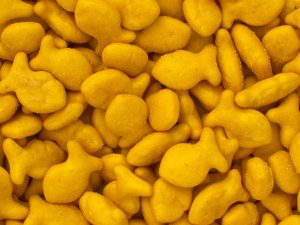
The extrusion process is also used to create nutrient-dense, shelf-stable snacks to combat malnutrition around the world. More than 200 million children under the age of 5 suffer from undernutrition,1 which is linked to 45% of deaths of children in this age group worldwide. In Cambodia, Nutrix, a tube-shaped wafer snack with a slightly sweet, slightly savory fish-based filling is used to combat malnutrition in that country. Previously, the Cambodian government relied on an imported nutrient-rich mix of milk powder, wheat flour, oat flour, and soy-protein as a therapeutic food. However, when prepared, this food became chewy and hard to swallow. Nutrix, on the other hand, is similar to a well-known local snack called Num Phom, uses local ingredients, and is more palatable. Children love it according to Lyndon Paul, co-founder of Danish Care Foods, manufacturer of Nutrix, and former product designer with Vissot, a local health food company.2 Since 2019, the private sector, non-governmental organizations, development agencies, and governments in Laos, Indonesia, Nepal, Bangladesh, and India have been interested in setting up Nutrix production facilities so that they can support malnutrition programs in their respective countries.
Today’s market size shows global extruded snack revenues for 2019 and projected for 2027. People are snacking more than they have in the past. In the United States, 95% of adults snack at least once a day, with 70% snacking two or more times a day. Many are foregoing entire meals and instead are snacking throughout the day. Consumers with busy lives who are looking for convenient, on-the-go, ready-to-eat foods to satisfy their hunger will contribute to the growing demand for extruded snacks over this time period. Health-conscious snackers will contribute to the growing demand for healthier ingredients in their favorite snack foods. Increasing attendance at entertainment venues, theaters, and other gathering places is expected to spur demand for these types of snacks at these sites. However, with governments throughout the world shutting businesses and imposing stay-at-home orders to slow the spread of COVID-19 in 2019 and 2020, demand for extruded snacks away from home are expected to decrease in the near future. Meanwhile, consumers are stocking up on shelf-stable, processed foods during the quarantine, including extruded snack foods. In an April 2020 Harris poll, 40% of those surveyed said they’ve been eating more snacks since the coronavirus pandemic began.
In 2019, more than 35% of extruded snack sales took place at supermarkets and hypermarkets, followed by convenience stores and online retailers. Potato-based snacks comprised more than 25% of revenues. Tapioca-based snack revenues are expected to increase at a compound annual growth rate (CAGR) of 4.1% from 2020 to 2027 due to increasing demand by younger generations for healthier snacks. Tapioca is cholesterol-free, low in sodium and free of common allergens, such as gluten and wheat. Tapioca in various forms is widely consumed in Latin America, Africa, and Asia. Europe had a more than 40% market share in 2019 owing to consumer snacking during social occasions and snacking on-the-go. The Asia Pacific region’s share is expected to increase the most, at a CAGR of 5.6%, due to the large populations in China and India and a growing corporate culture in which parties, where drinks and snacks are served, are encouraged.3 The market for extruded snacks is fragmented with many small local and international manufacturers. Major companies with large customer bases include Nestlé S.A.; The Kellogg Co.; Calbee, Inc.; PepsiCo, Inc.; and Campbell Soup Co.
1 Undernutrition includes wasting (low weight-for-height), stunting (low height-for-age) and underweight (low weight-for-age).
2 Nutrix was developed as a result of a collaboration between Vissot, Danish Care Foods, partners at UNICEF, the French National Research Institute for Sustainable Development, the University of Copenhagen, and the Department of Fisheries Post-Harvest Technologies and Quality Control, Fisheries Administration, Cambodia in addition to a grant from the Bill & Melinda Gates Foundation.
3 Any projections involving increased sales at large venues or gatherings may be less than accurate due to the disruption to the economy and daily life as governments closed businesses and imposed stay-at-home orders to slow the spread of COVID-19 in 2019 and 2020.
Geographic reference: World
Year: 2019 and 2027
Market size: $51.59 billion and $74.52 billion
Sources: “Extruded Snacks Market Size, Share & Trends Analysis Report by Product (Potato, Corn, Rice, Tapioca, Mixed Grains), by Distribution Channel, by Region, and Segment Forecasts, 2020 – 2027,” Grand View Research Report Summary, April 2020 available online here; “Extruded Snacks Market Size Worth $74.52 Billion by 2027 | CAGR: 4.7%: Grand View Research, Inc.,” CISION PR Newswire, April 30, 2020 available online here; “Malnutrition,” World Health Organization, April 1, 2020 available online here; “Nutrix – The Big Reach of Small Fish in Nourishing Cambodia,” CGIAR, March 31, 2020 available online here; “Food Extrusion,” Wikipedia, September 20, 2019 available online here; Carlie Porterfield, “In Coronavirus Quarantine, We’re Eating More Processed Snacks,” Forbes, April 28, 2020 available online here; Lacey Bourassa, “The Health Benefits of Tapioca,” Livestrong.com, September 16, 2019 available online here; “Snacking Motivations and Attitudes – US – January 2019,” Mintel Reports Overview, January 2019 available online here; Liz Parker, “State of the Industry 2019: Puffed and Extruded Snacks Find Growth Through Product Diversity,” Snack Food & Wholesale Bakery, July 23, 2019 available online here; Steve Dwyer, “Snacks: Diving Into Extrusion,” CSP, September 5, 2017 available online here; Sorpida Korkerd, et. al., “Expansion and Functional Properties of Extruded Snacks Enriched with Nutrition Sources from Food Processing By-products,” Journal of Food Science and Technology, January 2016 available online here; Tamar Lapin, “Americans are Handling the Coronavirus Pandemic by Binging on Snacks,” New York Post, April 13, 2020 available online here.
Image source: WikimediaImages, “food-eat-diet-goldfish-crackers-2202364,” Pixabay, April 4, 2017 available online here.
